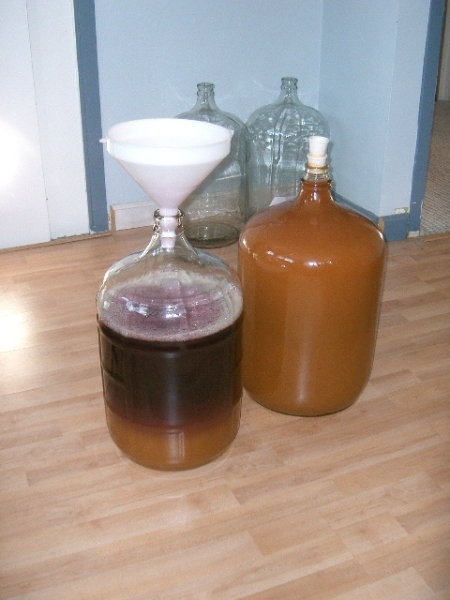With the temperature in the garage finally edging below freezing in a mid-December cold snap, it was time to do something with the four carboys that were settling quietly on top of the table saw. So yesterday we went into production, and bottled two batches of cider – about 10 gallons or 48 750 ml champagne bottles. When these hobby craft projects take on lives of their own and try to eat a whole weekend, Becky sighs and calls this strange compulsion toward anachronistic productivity “The Factory”. This time it was the cider bottling factory.
I started by sanitizing two Cornelius kegs, reassembling the fittings, and siphoning the cider from two 5-gallon carboys into the kegs. By tilting the carboy and arranging the keg and carboy at suitable heights, it is possible to siphon cleanly down to the last pint or so of sludge in the bottom. The next step is carbonation, from a 5 pound CO2 cylinder with a cheap single-stage regulator from the homebrew store. I rearranged the tubing to flow CO2 into the outlet of the keg, such that it was forced down the dip tube to bubble up through the cider. To carbonate quickly, I set the regulator to 35 psi and agitated the carboys for a few minutes, which forms fine bubbles inside the keg to speed diffusion of the gas into the liquid. The solubility is significantly higher at cold temperatures, so it helps that the cider is still ~32F. We set the quantity of CO2 by taste, but it seems to amount to around 20-25 psi when the cider is cold.
Then, we set up the bottling line on the kitchen counter and go to work. It looks something like this:

Alexis washes the bottles using a pressure-actuated valve that screws onto the faucet of the kitchen sink, then sanitizes them with a pump-action fountain sanitizer and inverts them in a pot to drain. I operate the bottling system, which I borrowed from Holly; one of these days I’m going to make one for myself. A counterpressure bottling rig is basically a two-way valve that serves to pre-pressurize the bottle with CO2 before introducing the cider, and to control the flowrate of cider into the bottle by regulating the flow of gas out of a fitting at the top. Holly made his from parts ordered from McMaster-Carr, but lots of designs are available for sale on the internet. To operate it, you introduce the flow tube on the bottom of the valve assembly into the bottle and seat the rubber stopper in the mouth of the bottle so it seals, then move the valve to the gas inlet side briefly to pressurize the bottle with CO2 from the regulator. You then quickly move the valve to the cider inlet side, and cider begins flowing into the bottle, driven by the pressure in the keg, which is also hooked up to the regulator. The flowrate of cider is controlled by manipulating a threaded fitting at the base of the valve; the gas escapes from the top of the bottle via a concentric tube that surrounds the flow tube. When the cider reaches the desired level, you move the valve to the center (off) position, and the remaining pressure bleeds off through the fitting. The net result is that the bottle is filled without triggering the CO2 to come out of solution. Alexis then caps the bottles with a lever-action capping apparatus, and places the bottles back in the case.
The temperature continued below freezing, and I worried about the two glass carboys in the garage, so as soon as the kegs were empty I cleaned them and siphoned the cider from the next two batches. I then brought the kegs inside, and carbonated the cider while it was still cold. I think I’ll need more bottles to finish off those batches though. We also have one six-gallon carboy on secondary with the single-variety Roxbury Russet cider in it; it’s taken forever to settle but is finally starting to clear so I may rack it again, or just let it sit until I have a keg available for it.
I also started one last batch of cider, with juice I bought from Steve Wood and company at Poverty Lane. I got 9.5 gallons, and started a 6 gallon batch, plus an experimental batch with a gallon of Trader Joe’s pure blueberry juice mixed in. Steve is a purist in matters of cider, and would rather drink clorox than cider adulterated with other fruit, but in the interest of science I feel compelled to try experiment beyond the bounds of tradition, and make my own mistakes. In my defense I’ll note that that West County Cider down in MA also makes a blueberry-apple cider, though I’ve never tried it. It was kind of cool – the Poverty Lane cider was almost 8% potential alcohol while the blueberry was just over 5% – significantly less dense, and the blue juice mixed with the cider but stayed mostly on top, so the contents of the carboy segregated by color. Here’s the cider, including the one with funny purple juice – don’t tell Steve.



